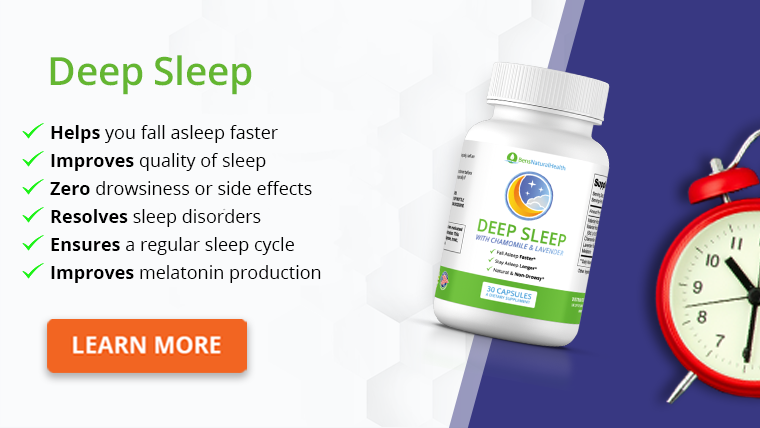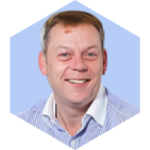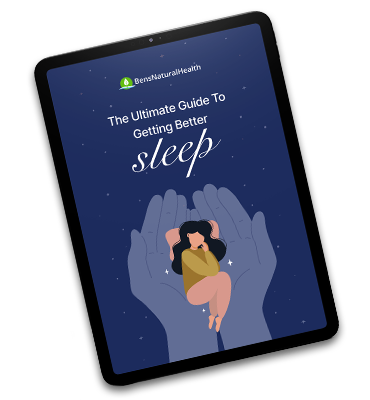Sleep has become a popular topic recently, primarily due to the accumulation of evidence for its pivotal role in promoting and maintaining physical, psychological, and emotional health.
While this increased interest has led to people being more aware of their sleep, there is also the potential for people to over-monitor, and this can lead to increased anxiety and stress when someone does not feel that they have had sufficient good quality sleep, which in itself could lead to poor sleep.
As such, it is essential to differentiate normal variations in sleep from a sleep disturbance and consequently a sleep disorder, and signpost people as to when and where they should go for help.
Get Your FREE Sleep Guide
- Learn how to naturally improve your sleep
- Dietary recommendations, supplements, and lifestyle changes
- Developed exclusively by our medical doctor
Signs of a sleep disorder
The most sensitive signal of any sleep issue is feeling tired or sleepy in the daytime. This potentially suggests a problem with the quantity, quality, or timing of your sleep.
While this tends to capture most people with a sleep disorder, it is not very specific, so determining what the condition is, if a disorder even exists, cannot be made on that basis alone.
Additionally, this definition does not differentiate normal variations in sleep – even good sleepers will have the occasional poor night of sleep (Molzof et al., 2018) from a sleep disturbance, which we would classify as a brief period of poor sleep, usually in response to some sort of challenge (e.g., biological – such as a change in medication or physical health or psychological – such as a period of stress).
To that end, we rely on diagnostic manuals to differentiate the various kinds of sleep disorders. However, it is important to note that an individual can have two sleep disorders at the same time. In this instance, it is helpful to have a healthcare professional to determine the order of treatment.
Types of sleep disorders
Presently, we can use one of three diagnostic manuals (nosologies) to help diagnose a sleep disorder, based upon its symptoms.
- International Classification of Diseases (ICD – World Health Organisation, 2011)
- Diagnostic and Statistical Manual of Mental Disorders (DSM – American Psychiatric Association, 2013)
- International Classification of Sleep Disorders (ICSD – American Academy of Sleep Medicine, 2014).
Considering they are all, more or less, in agreement these days, we will focus on the ICSD, arguably the most comprehensive.
The ICSD outlines six main categories of sleep disorder: 59 specific sleep disorders and six sleep-related medical conditions embedded within these categories (Table 1). For that reason, we will focus on the most common sleep disorders in each category.
Insomnia
Insomnia Disorder is defined on the basis of a self-reported difficulty in getting off to sleep (sleep-onset insomnia), staying asleep (sleep maintenance insomnia) and/or waking up earlier than needed, and being unable to get back to sleep (early morning awakening).
The problem should have existed for at least three months (before that, it is termed acute insomnia) and occur at least three nights per week. Finally, the difficulty should be present despite having adequate sleep time and impairing daily functioning (memory, attention, productivity, mood, etc.).
The primary consideration regarding the diagnosis of insomnia relies on the individuals’ self-report, and it is rare to look for objective verification unless another sleeping disorder is suspected.
Circadian Rhythm Sleep-Wake Disorders (CRDs)
CRDs occur when there is an extreme misalignment between the individuals’ internal biological clock and the external world in which they live. An Advanced CRD (ASPS) happens when an individual wants/needs to sleep in the early evening and will wake in the early hours of the morning.
A delayed CRD (DSPS) occurs when an individual wants/needs to sleep in the morning’s early hours and will wake if uninterrupted, mid to late morning. Further, jet lag disorder (where our biological clock is still set to our departure destination following travel, for a few days) and shift-work disorder (working outside typical daytime hours for three months or longer) are also forms of CRD when there is a complaint of poor sleep.
The main consideration regarding a diagnosis of a CRD is that people often attempt to sleep at ‘typical’ times, and this can translate into problems getting off to sleep (in the case of DSPS) or early morning awakenings (in the case of ASPS) which could easily be interpreted as symptoms of insomnia.
The question we ask to differentiate between the two is; if you were on vacation or had a day off with no commitments and could sleep and wake whenever you wanted, would you still have this difficulty getting in off to sleep or waking too early? If the answer is no, it is more likely to be a CRD than insomnia.
Sleep-Related Breathing Disorders (SRBDs)
Under the framework of SRBDs, there are 17 diagnosable sleep disorders, all relating to respiration abnormalities during sleep. The most common is Obstructive Sleep Apnea (OSA) and Central Sleep Apnea (CSA), although many patients will meet the criteria for both conditions.
An apneic event occurs when there is a brief interruption in breathing during sleep, and this can be full cessation (an apnea) or partial cessation (a hypopnea). Consequently, this results in lower oxygen levels and higher levels of carbon dioxide in the blood, which creates arousal from sleep to alert the brain to begin breathing again. This is usually accompanied by a sharp intake of breath/gasp for air or choking.
The number of apneas and hypopneas recorded per hour of sleep indicates whether the individual has apnoea or not and, if they do, whether it is mild, moderate, or severe. The difference between OSA and CSA is mainly around how the apnea originates with OSA being from airway obstruction, usually from the tongue or fatty tissues of the throat, and CSA from when the brain fails to send signals to the muscles that control breathing.
One of the main challenges with most, if not all, SRBDs is that although these pauses in breathing disrupt sleep, they are often not remembered in the morning. This poses a difficulty in determining the need for testing, especially for individuals who live or sleep alone.
To diagnose any SRBD, the individual will have a sleep study, which can involve overnight measurements of breathing, airflow, respiratory effort, and blood oxygen levels to determine the frequency of apneic events. Traditionally this was done in a sleep laboratory, although we are seeing home recording becoming increasingly popular.
Central Disorders of Hypersomnolence
As the name suggests, disorders in this category are defined based on excessive sleepiness. The most common disorder in this category is Narcolepsy, which has two variants (Type 1 and 2).
Both disorders are characterized on the basis of an irrepressible need for sleep or unintentional lapses into sleep during the day for at least the previous three months. Levels of sleepiness are usually tested in a lab using a Multiple Sleep Latency Test (MSLT) whereby the individual is given several opportunities to nap during the day and if they fall asleep quickly (within 8 minutes on average) and enter REM during two or more of those nap opportunities being a good indicator.
Type 1 has to be accompanied by cataplexy (a sudden weakness or loss in muscle tone) and/or low hypocretin levels (a brain hormone associated with wakefulness). In contrast, Type 2 should have no cataplexy or low levels of hypocretin.
Parasomnias
All parasomnias are defined on the basis of being undesirable physical events or experiences that occur during sleep and can involve quite complex actions (e.g., walking, talking, eating, and even driving). However, several types of parasomnias are differentiated mainly into two types, based upon when they occur.
Parasomnias in the first third of the night are labeled as Non-REM-Related Parasomnias where there is a strong likelihood that the individual has had a partial awakening from a deep sleep and in the last third of the night being labeled REM-Related Parasomnias (RRPs) where it is more likely that a partial awakening has occurred during REM.
One specific form of RRP is REM Sleep Behaviour Disorder (RBD), which is associated with Parkinson’s Disease (Boeve, 2013). In this instance, the individual is likely to act out dreams, which can cause injury to themselves and/or their bedpartner.
To diagnose RBD, a sleep study is performed. In contrast, for most of the other parasomnias, self-reports of these behaviors by the individuals or members of the same household are sufficient.
Sleep-Related Movement Disorders
All of the disorders in this category are characterized by unintentional but relatively simple movements at sleep onset or during sleep. Restless Legs Syndrome (RLS) and Periodic Limb Movement Disorder (PLMD) are the two most common and share a close association, but are often confused.
The main differentiator between the two conditions is that whereas uncomfortable sensations characterize RLS in the legs, PLMDs are characterized by small involuntary jerks.
Further, RLS predominately occurs and worsens in the evening and can prevent the onset of sleep. In contrast, PLMD occurs during sleep and results in arousals or awakenings in the night, fragmenting sleep.
Unlike a diagnosis of RLS, which is largely based on self-report, a sleep study is usually used to diagnose PLMD, with 5 or more events per hour of sleep is the diagnostic threshold.
Tracking your symptoms
The most common and practical way to track your symptoms is by completing a sleep diary every morning for a minimum of a week.
The sleep diary should contain questions about:
- the time you went to bed
- the time you intended to sleep
- how long it took you to get off to sleep
- how many times you woke in the night and for how long you were awake
- the time you finally woke and the time you got out of bed.
Usually, a sleep diary will also contain a question or two about your perceived sleep quality (Carney et al., 2012). Whilst this method is good for tracking some sleep disorders, such as Insomnia, it may be less helpful for a sleep disorder that occurs during the night (occult sleep disorders) where sleep is interrupted, but those interruptions may not be remembered in the morning.
For those types of sleep disorders (e.g., OSA, PLMD, or Parasomnias), it may also be worth tracking how sleepy you are during the day, as well as it is this sleep fragmentation that translates to daytime sleepiness.
If you are giving yourself enough time to sleep, needing as opposed to wanting to sleep during the day is a good sign that something needs to be investigated. We see a surge in sleep tracking technology. This can help in some circumstances, such as tracking sleep over a longer period to examine CRDs or when completing a sleep diary is problematic.
However, the challenge with many of these devices is to help identify normal variations in sleep and sleep problems; they cannot tell you whether the problem meets the diagnostic threshold for a sleep disorder or indeed which disorder it might be.

Managing a sleep disorder
When it comes to managing a sleep disorder, it is largely down to the disorder. There are different management strategies for different disorders, which underscores a proper diagnosis from a sleep specialist.
For some sleep disorders, such as Narcolepsy, some Parasomnias, and PLMD/RLS, medication is the predominant strategy used. That said, we are seeing more non-pharmacological management strategies being developed and adopted in tandem with advances in the research and practice of behavioral sleep medicine.
In terms of Insomnia Disorder, there are two main options – pharmacological and non-pharmacological. Pharmacological treatments tend to be either benzodiazepines or benzodiazepine receptor agonists, although it is not uncommon to be prescribed an antidepressant or anxiolytic instead.
Some of the concerns about frequent benzodiazepine use (addiction, withdrawal, and tolerance) paved the way for non-pharmacological approaches to be explored, designed, and tested. On the basis of this work, Cognitive Behavioral Therapy for Insomnia (CBT-I), a multicomponent management strategy, was developed. CBT-I usually involves six to eight weekly sessions, whereby incompatible sleep attitudes, beliefs, and behaviors are identified and managed through a series of techniques.
CBT-I has been subject to hundreds of trials and has been shown to be effective for the majority of people, and the results appear to be long lasting. Based on the evidence, several organizations now advocate CBT-I as the first-line treatment for Insomnia Disorder (Riemann et al., 2017; Qaseem et al., 2016).
For sleep apnea, the most common management strategy is Continuous Positive Airway Pressure (CPAP), especially with moderate to severe cases. In mild cases, there is evidence that a Mandibular Advancement Device (MAD) can help (Marklund et al., 1998). A MAD is like a mouth guard, but it is positioned in such a way as to bring the bottom jaw forward slightly, which tenses the muscles around the throat, keeping the airway open at night.
For circadian rhythm disorders, there are a couple of options – melatonin and bright light therapy. Whereas melatonin is naturally produced, through the pineal gland, in response to darkness, it has been used, through supplementation, as a method to alter the circadian rhythm (usually to bring it forward) in order to manage DSPS.
In a similar vein, controlled exposure to bright light can also alter the circadian rhythm. The challenge with both of these approaches is getting administration right, which is where a sleep specialist is most helpful.
When to see a specialist
Although the diagnostic nosologies provide duration criteria for some of the sleep disorders (e.g., Insomnia Disorder), which would imply when it might be time to see a specialist, early interventions that are briefer and less intense are very effective in several cases (Ellis et al., 2015).
As such, it is important to see a sleep specialist if you have any concerns about the quality, quantity, or timing of your sleep, and earlier is always better. As with most other diseases, disorders, or conditions – the longer you wait, the more problematic and embedded the issue can become.
The need and intensity for treatment are likely to increase. Conversely, it is important to remember that one or two poor nights are quite normal and certainly do not mean you have a sleep disorder.
Conclusion
The topic of sleep disorders does underscore the complexity of sleep, with different disorders being associated with different stages of sleep and numerous types of occurrences that can interrupt sleep.
Sleep health is important, playing a pivotal role in our physical and mental well being. Therefore if you feel that you have a sleep problem that does not appear to be getting better, you should locate a good sleep medicine specialist for an assessment.







